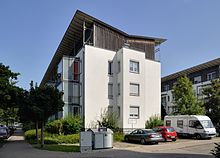Butterfly roof

The butterfly roof is a roof shape in which two sloping roof surfaces are connected in a V-shape. This shape is practically the inversion of the conventional saddle roof is: Instead of a central roof ridge has the butterfly roof a central channel ( throat ) and the place of eaves two parallel ridges on the long sides of the building. Viewed from the narrow sides, the resulting shape resembles splayed butterfly wings, hence the name.
The butterfly roof is a comparatively rare roof shape in residential buildings , which is only used more often from the second half of the 20th century. This is due to the fact that the construction of the butterfly roof entails technical difficulties: instead of rainwater being diverted away from the building, with the butterfly roof it collects in a central channel above the central axis of the building, from where it flows over the two ends (usually over Downpipes ) to be derived. Sometimes there is even internal drainage through the building. In the case of heavy rain, water can quickly build up in the middle of the building and leaks can lead to major water damage. Clearing snow is also problematic. The butterfly roof therefore places higher demands on the roof material and requires more maintenance than many other roof forms. There are similar construction-related difficulties with the related shape of the trench roof . However, a butterfly roof can also serve as a means for better air circulation in the interior, especially in tropical regions.
An example of the use of butterfly roofs in residential architecture are the wings of the Kreuzberg Tower ensemble , which the New York architect John Hejduk (1929–2000) designed for the 1987 International Building Exhibition in Berlin.
The roof shape is used comparatively more frequently for flight roofs , in particular for free-standing weather protection roofs , for example as a platform roof . Other areas of application are e.g. B. canopies at gas stations or border clearance systems. The roof is usually supported by a series of supports in the middle of the roof, so that there are no supports at the edges when boarding a train or when refueling or checking a vehicle. An aesthetic function is fulfilled by a butterfly roof implemented as a flying roof that appears to float over a building, i.e. H. There is an aerial floor between the top closed floor of the building and the flight roof .
Footnotes
- ↑ dormitories for orphans Baunetzwissen.de, Retrieved on April 9, 2013
- ↑ Articles and images on John Hejduk's Kreuzberg Tower
